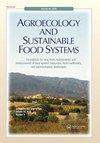Landscape agroecology: woody vegetation heterogeneity and its association with natural and human factors at a multifunctional peasant socio-ecosystem from a semi-arid mountain range area (Dry Chaco, Argentina)
IF 2.6
3区 农林科学
Q1 AGRICULTURE, MULTIDISCIPLINARY
引用次数: 0
Abstract
ABSTRACTIn this study we investigate the landscape of a multifunctional peasant socio-ecosystem using a dialectic and complex theoretical-methodological framework rooted in agroecology. We describe vegetation floristics and structure, as well as biophysical and anthropic variables. We use maps, multivariate analysis and validation workshops to integrate and analyze information. The vegetation showcases distinct typologies, marked by gradual, non-linear variations, without precise boundaries tied to biophysical and anthropic drivers. Furthermore, based on vegetation structure and floristic heterogeneity, this agroecosystem constitutes a well-managed multifunctional native forest landscape, exemplifying a case of biocultural conservation.KEYWORDS: Dry foresttraditional agricultural landscapeecological complexityhuman-environment relationshipsland use historyagroecology landscapeparticipatory approach AcknowledgmentsThis research would not have been possible without the collaboration and participation of the entire community of San Ramón-San Luis-El Cautivo. Not only did they lend themselves to answering our questions and accompanying us on the walks, they also accommodated us in their homes. The interaction with the families not only allowed our work but also enriched us as human beings. We also thank Laura Fernández, Emma Trono, Paula Ramos and Mirtha Lezana from the NG “Bienaventurados los Pobres (BePe)” for their support, knowledge and company in the territory. Although a small portion of the transdisciplinary project is presented in this article, it was possible thanks to the bond built throughout the project and an ethnographic approach.Disclosure statementNo potential conflict of interest was reported by the author(s).Data availability statementThe data used to support the findings of this study are available from the corresponding author upon reasonable request.Supplementary materialSupplemental data for this article can be accessed online at https://doi.org/10.1080/21683565.2023.2254719Additional informationFundingThis work was supported by the “Secretaría de Ambiente y Desarrollo Sustentable” and “Agencia Nacional de Promoción Científica y Tecnológica” (Argentina) under Grant [PICTO 0062, 2014].景观农业生态学:半干旱山区多功能农民社会生态系统中木本植被异质性及其与自然和人为因素的关系(阿根廷干查科)
在这项研究中,我们使用植根于农业生态学的辩证和复杂的理论方法框架来研究多功能农民社会生态系统的景观。我们描述了植被区系和结构,以及生物物理和人为变量。我们使用地图、多变量分析和验证研讨会来整合和分析信息。植被表现出独特的类型,其特征是逐渐的非线性变化,没有与生物物理和人为驱动因素相关的精确边界。此外,基于植被结构和植物区系异质性,该农业生态系统构成了一个管理良好的多功能原生森林景观,是生物文化保护的典范。关键词:干旱林;传统农业景观;生态复杂性;人-环境关系;土地利用历史;他们不仅愿意回答我们的问题,陪我们一起散步,还让我们住在他们的家里。与家庭的互动不仅使我们的工作得以开展,也丰富了我们作为人的生活。我们还要感谢来自“双年创业”组织的Laura Fernández、Emma Trono、Paula Ramos和Mirtha Lezana在该地区的支持、知识和陪伴。虽然本文只介绍了跨学科项目的一小部分,但由于整个项目建立的纽带和民族志方法,这一点成为可能。披露声明作者未报告潜在的利益冲突。数据可用性声明用于支持本研究结果的数据可根据通讯作者的合理要求提供。本研究得到了“Secretaría环境与可持续发展”和“阿根廷国家机构Promoción Científica y Tecnológica”(阿根廷)的资助[PICTO 0062, 2014]。
本文章由计算机程序翻译,如有差异,请以英文原文为准。
求助全文
约1分钟内获得全文
求助全文
来源期刊

Agroecology and Sustainable Food Systems
AGRICULTURE, MULTIDISCIPLINARY-GREEN & SUSTAINABLE SCIENCE & TECHNOLOGY
CiteScore
4.80
自引率
7.70%
发文量
73
期刊介绍:
Agroecology and Sustainable Food Systems is devoted to the rapidly emerging fields of agroecology and food system sustainability. By linking scientific inquiry and productive practice with transformative social action, agroecology provides a foundation for developing the alternative food systems of the future. The journal focuses on the changes that need to occur in the design and management of our food systems in order to balance natural resource use and environmental protection with the needs of production, economic viability, food security, and the social well-being of all people.
Agroecology and Sustainable Food Systems examines our current food systems from production to consumption, and the urgent need to transition to long-term sustainability. The journal promotes the study and application of agroecology for developing alternatives to the complex problems of resource depletion, environmental degradation, a narrowing of agrobiodiversity, continued world hunger, consolidation and industrialization of the food system, climate change, and the loss of farm land. The journal uses a food systems approach, and seeks experiences in agroecology that are on-farm, participatory, change-oriented, and backed by broad-based methodologies of sustainability analysis and evaluation.
 求助内容:
求助内容: 应助结果提醒方式:
应助结果提醒方式:


